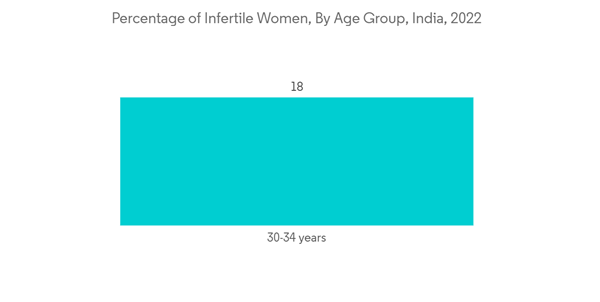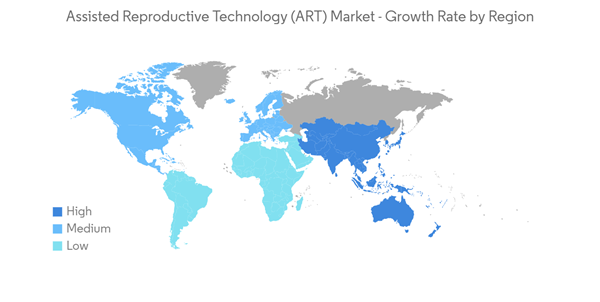Key Highlights
- The increased social and economic burden caused by the novel COVID-19 gradually became worrisome for the healthcare sector. Various research found that the novel coronavirus invades the target cell by binding to angiotensin-converting enzyme 2 (ACE2), which is widely expressed in the ovaries, uterus, vagina, and placenta. In addition, research studies have been published on the impact of the pandemic on the fertility rate.
- For instance, a research study published in the BMJ Open Journal in February 2021 stated that SARS-CoV-2 interrupts female fertility by regulating ACE2 and interfering with ART procedures. Hence, fertility treatments increased during the pandemic and affected the market growth considerably. With the declining COVID-19 cases and large-scale vaccination, the studied market is expected to regain its full potential over the forecast period.
- Factors such as rising cases of infertility due to late marriages, stressful lifestyles, obesity, high junk food intake, smoking, alcoholism, and drug addiction are driving the adoption of ART.
- For instance, according to the data published on female infertility in the National Library of Medicines in December 2022, globally, 11% of women who had a previous live birth were unable to have another, and 2% of women aged 20 to 44 were unable to have any live births at all. As per the above source, infertility rates are higher in Eastern Europe, North Africa, and the Middle East. Hence, owing to the higher infertility, the demand for ART techniques is expected to increase over the years and drive the growth of the market.
- Further, the declining birth rate in different regions across the world and the rapid increase in the geriatric population are expected to have a significant impact on the ART market. For instance, according to the data update by Eurostat in April 2022, the crude birth rate (the number of live births per 1,000 persons) in the European Union is declining gradually, reaching 9.1 in recent years. Hence, the demand for ART technology is expected to grow over the forecast period, fueling the overall market growth.
- In addition, the increasing number of single parents and awareness about same-sex marriages and assisted reproductive technologies are also expected to play a significant role in the growth of the ART market over the forecast period. For instance, according to the 2022 update of the Human Rights Campaign (HRC) Foundation, the number of countries where same-sex marriage is legal has increased to 32 in 2022, and parliamentary or court proceedings are underway in several countries, and this number is further expected to increase. Thus, with the increase in same-sex marriages, the demand for ART techniques is expected to increase significantly, which will boost growth in the studied market.
- However, changing government regulations along with socio-ethical issues and high costs associated with ART are expected to restrain the growth of the assisted reproductive technologies (ART) market is expected to grow during the forecast period.
Assisted Reproductive Technology (ART) Market Trends
In-Vitro Fertilization (IVF) Segment is Expected to Grow Significantly During the Forecast Period
- Compared to natural and conventional ways of conception, in vitro fertilization (IVF) is very different; following an infertility test, when the doctor tries to determine sexual behaviors and any specific causes of infertility, the treatment is frequently administered. The doctor removes the ovaries' eggs, which are then fertilized in a lab, and the fertilized eggs are then kept in an environment that is favorable until they become viable embryos. At this point, one is returned to the mother's womb. Due to the rising burden of lack of natural tendency to conceive, the demand for IVF is increasing among women of reproductive age and is expected to drive the segment's growth.
- The IVF segment is expected to grow due to the high procedural success rate and continuous advancement. For instance, according to an article published in May 2023 by Kin Fertility Clinic, in recent years, the success rate for IVF for women under 30 was found to be 21.2% in Australia, and age, quality of the embryo, and lifestyle factors are among the major factors for the success of an IVF procedure. Hence, due to the success rate of the procedure, the segment is expected to grow significantly during the forecast period.
- Moreover, the advancement in IVF technology, growing awareness, government initiatives to regulate surrogacy, and increasing coverage of IVF under insurance are the other major factors expected to play a crucial role in the growth of the studied segment. For instance, in June 2022, the Indian state Odisha constituted a state-appropriate authority and set up the state-assisted reproductive technology and surrogacy board with the objective of regulating IVF clinics and prohibiting commercial surrogacy.
- The Assisted Reproductive Technology (ART) Act came as a ray of hope for infertile couples battling legal, ethical, and social tussles. The IVF and ART clinics will now be registered following the approval of the five-member authority led by the Special Secretary (Public Health) of the Health and Family Welfare Department. Hence, such initiatives would increase market growth in the upcoming period.
North America is Expected to Occupy a Major Market Share Over the Forecast Period
- North America is expected to hold a significant market share in the global assisted reproductive technology market over the forecast period owing to factors such as increasing infertility in the region and initiatives by public organizations.
- The United States in the North American region is expected to be a major market for the assisted reproductive technology (ART) market over the forecast period due to the robust healthcare infrastructure and decreasing fertility. For example, data updated by the Census Bureau in April 2022 showed that fertility rates of women ages 20-24 declined by 43% in recent years, with only 66.59 births to every 1,000 women in that age range, indicating a 42.79% decline in fertility from past decades in the United States.
- Furthermore, as per a study published by the National Institute of Health (NIH) in January 2023, nearly 11% of women of reproductive age, i.e., 18 to 35 years in the United States, have experienced fertility problems in current years. Thus, with the increasing rate of infertility among women, the demand for ART techniques is expected to increase and drive the overall market growth in the region.
- Furthermore, the number of clinics present in the region is expected to create opportunities for the adoption of ART and drive the market's growth in North America. For instance, according to the data updated by Centers for Disease Control and Prevention (CDC) in March 2023, nearly 500 clinics provide services to patients seeking to overcome infertility in the United States. CDC collects data from all fertility clinics in the United States and calculates standardized success rates for each clinic. This gives potential ART users an idea of their average chances of success. Hence, the availability of such data for ART users and clinics offering services is anticipated to fuel the segment's growth over the analysis period.
- Further, the advancements in ART technology and the launch of new products are expected to boost the market's growth. For instance, in June 2022, FUJIFILM Irvine Scientific, Inc. launched Heavy Oil for Embryo Culture, a sterile mineral oil with an optimal weight viscosity that provides the ideal balance between ease of use and protection for IVF laboratory. Therefore, due to the aforementioned factors, North America is expected to have a major market share in the studied market.
Assisted Reproductive Technology (ART) Industry Overview
The assisted reproductive technology (ART) market is moderately competitive, with the presence of some key players in the market. The key player in the assisted reproductive technology (ART) market includes - Bloom IVF Centre, CooperSurgical Inc., Ferring B.V., Hamilton Thorne Inc., FUJIFILM Irvine Scientific, Inc., Laboratoire CCD, Microm Ltd, Nidacon International AB, OvaScience Inc., and Vitrolife.Additional Benefits:
- The market estimate (ME) sheet in Excel format
- 3 months of analyst support
This product will be delivered within 2 business days.
Table of Contents
Companies Mentioned (Partial List)
A selection of companies mentioned in this report includes, but is not limited to:
- Bloom IVF Centre
- CooperSurgical Inc.
- Ferring B.V.
- Hamilton Thorne Inc.
- FUJIFILM Irvine Scientific, Inc.
- Laboratoire CCD
- Microm Ltd
- Nidacon International AB
- OvaScience Inc.
- Vitrolife
- Esco Medical
- Memmert GmbH + Co.KG










